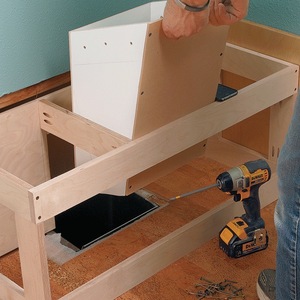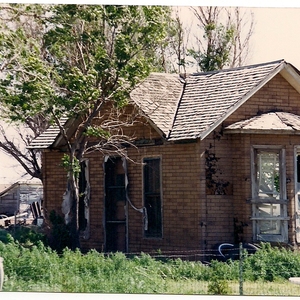Here’s my dilemma. Have a 100 yr. old farmhouse in s. minnesota. It’s in good condition and has rock wool? blown in walls and under floor in attic. Story and 3/4 by the way. I would like to seal up the attic and blow it full of cellulose to warm up the upstairs and eliminate my ice dam problems. BUT in searching the archives, I’ve found that it may be a bad idea because the house has a partial basement (rock) and the part that is crawl space is inaccessable, not sealed with plastic, and is a big mystery. Some sites claim that sealing the attic on such a house may cause it to rot and turn into a smoldering pile of rubble. The crawl has heat ducts in it and is at house or basement temp. The ground is sandy here and we don’t have basement water problems. I’m looking for advice . Thanks. Pete
Discussion Forum
Discussion Forum
Up Next
Video Shorts
Featured Story

The "She Build" initiative is empowering women in Seattle, WA by ensuring they have safe, healthy homes.
Featured Video
How to Install Exterior Window TrimHighlights
"I have learned so much thanks to the searchable articles on the FHB website. I can confidently say that I expect to be a life-long subscriber." - M.K.

















Replies
Why would sealing the attic cause it to rot?
Maybe it's nonsense but some claim that you must seal the crawl space or moisure will migrate up through the house and cause problems. I imagine if a person were to monitor the humidity and keep it under control, it wouldn't be a problem.
Greetings gzpete,
I see you are a first time poster so Welcome to Breaktime.
Hang on, some advice should be arriving shortly.
Cheers
By all means, insulate that attic! Hot air heat in Minnesota? I would think the air inside is pretty dry in the winter. But as with any attic in a heating climate, make sure the attic is well ventilated to allow moisutre to escape. To reduce the amount of moisture getting into the attic, do your best to seal any air leaks from the heated space into the attic.
Seal air leaks, insulate and ventilate and you will be more comfortable, save energy and prevent ice dams.
Al Mollitor, Sharon MA
By story and 3/4 do you mean you have kneewalls in the attic with the roof beginning atop those kneewalls rising to a peak in the middle of the house? How high are those walls? Is this second floor area being considered for a living area?
By having both a crawlspace and a basement area, is the building a rectangular shape all under one roof or was an addition added at some time as in an ell or extension?
The upstairs rooms have 8 ft ceilings and on the roof side of the room it breaks at 6' 4" and I have about 30" of sloped ceiling following the roof pitch (12/12). From the attic, I can see down the rafter stud bays all the way to the facia board. I had thought of stuffing some fiberglass batts down these stud bays to where the side wall meets the rafters, then blow the stud bays full of cell. This would prevent the cells from going all the way to the facia.BUT this would not allow venting stud bays. SO the other option would be to rip down the lath and plaster on the ceiling slope and install 2" blue foam board between the rafter studs(2x4's)and maybe a 1"foam board (with the foil on it) below that, then sheet rock. That would give me an inch+ of vent space under the roof sheathing. Then I could get some soffit venting going on and install some roof vents, blow more cell on the attic floor and get the attic temp. the same as outside. What do you think? O'ya the basement is about 30' x 30' and the crawl space is about 14' x 28' , two rectangle offset about 8'.
They make thin foam forms which you can staple to the sheathing. They are like 99 cents at HD, used whole for a 24" OC rafters and split in half for 16" OC. This gives you a 1" deep channel along the sheathing for ventilation. Then you can put in fiberglass, cellulose, or whatever underneath but still maintain the airflow. Fiberglass might be a good option here since you could cut vents into the fascia board and not have to worry about them being blocked, as would be the case with loose cellulose. You will need some vents in the fascia and the somewhere up high in the roof to vent properly. The added advantage to this ventilation is that it will cool down these rooms in the summer as well. I think the big orange Home Depot home manitenance book will have pictures of what I'm describing. How far beyond the walls do the rafters extend? This might determine the best approach.
The fascia board is only about 14" away from the siding so I don't have a very big overhang. That seems common on an old house w/ 12-12 pitch roof. Also I don't have a horizontal soffit like a modern house. Mine is a wood panel attached to the underside of the rafter tails. Vents could probably be drilled into this soffit area and screened plugs installed. I know what you mean about the ins. baffles. They would work good if I gutted the lath and plaster off the slope part of the ceiling. Thanks to all the posters on this fine board for the info. It sure helps to get some other opinions(other than the mrs.)
Thanks. pete
Assuming I've got the correct link, Mike Smith used those on that addition he was working on a month or two ago. He and his crew used expanding foam to seal the edges so that they could blow insulation in (without it infiltrating the vent gap). That was a good thread, worth reading the whole thing.
http://forums.taunton.com/tp-breaktime/messages?msg=44500.145
Although.... Where's the challenge when the wall and bay is wide open? Much better if you're balancing on yer head in the attic (either 100 F or -10F, take your pick) while trying to feed 16' of foamboard (8' pieces carefully duct-tapped together) down a narrow gap.. trying to keep it in place so that you can jam some insulation in behind it... all in the warm glow of a single bulb about 20' behind you somewhere. ;)jt8
I forgot to let you know that the crawl in question was original equipment. I have added a downstairs bathroom over a accessable and insulated crawl. This house was quite a design at the time and is really sharp now. Has a complex roof line with 6 gables, lots of valleys ,steep roof , and is coming back in style like the stuff there building nowdays.
the part that is crawl space is inaccessable, not sealed with plastic, and is a big mystery.
Let me see if I'm up to speed. By 1 3/4 story, I assume you mean a two-story house with gable bump-ins or some such and then an attic above the second story?
"not sealed with plastic" do you mean you don't have a moisture barrier on the ground of the crawl space? And how "inaccessable" do you mean? PITA to get in there, or a matter involving picks and shovels? If there are heating ducts in there, I might be tempted to insulate them.
As far as the attic, if you insulate it while providing for ventilation, you should be ok. Between insulating the living space and providing ventilation in the attic, it should reduce moisture (when present) and provide a 'cool' roof (thereby reducing ice dams).
Someone can correct me if I'm wrong, but I think true rock wool is a mineral based product made from basalt or some such. Far as I know, it works just fine. Shouldn't support mold/mildew (since its a mineral). In a 100 yo house, probably the biggest complaint would be that the rw has settled or that you'd like it to be a couple more inches deep.
I don't see why you couldn't put cellulose on top of it if need be.
Oh, and welcome to Breaktime!
You might want to look at the top of the wall(s) where the vent pipes go into the attic. I was rewiring my kitchen and bath a couple of years ago and discovered that the wet wall between the kitchen and bath was open on top, except for a few pieces of wood laying on top. Pretty well explained the draft falling into the basement, and the frost on the inside of the roof.
"I cut this piece four times and it's still too short."
Thanks for the tip. I'll check it out. These balloon framed houses have lots of ventilation!
Thanks for the reply. Check my response to "rez" for some of your questions. By inaccessable I mean I'd have to knock out some rock in the basement wall to weasel in there. Years ago someone installed the HVAC ducts under there but I have no idea how they could have done it. There is no vapor barrier sealing the crawl because the last time someone was in there, I don't think plastic had been invented yet!
john .. i was always told that "rock wool " was some byproduct of steel mills and 'slag"
i wonder ...
edit: ok , i looked it up..
<<<<
What is rock wool?
View Image Audrey Aronowsky
Hi Audrey,
I thought you were joking, but I looked it up in a geological dictionary. Here is what it said:
MINERAL WOOL: A substance outwardly resembling wool, presenting a mass of fine interlaced filaments, made by subjecting furnace slag (or certain rocks) while molten to a strong blast. Being both insectproof and fireproof, it forms a desirable packing for walls, a covering for steam boilers, etc. (Standard) Called also Mineral cotton; Silicate cotton; Slag wool. >>>>>
Mike Smith Rhode Island : Design / Build / Repair / Restore
Edited 11/21/2004 12:35 am ET by Mike Smith
john .. i was always told that "rock wool " was some byproduct of steel mills and 'slag"
Ok, now you got me curious. I thought the slag stuff was a close cousin to rock wool.
.....
Ok, here we go:
Rock Wool
Man-made material comprised of natural minerals like basalt or diabase.
Slag wool
Man-made material made primarily from iron ore blast furnace slag.
http://www.naima.org/pages/resources/faq/glossary.html
What the heck is diabase?! And could I tell you what the difference in appearance is between rock and slag wool? Nope. When the crud runs out of a wall or rains down from the ceiling I just always refer to it as rock wool. Might be slag wool for all I know.
In my limited experience, I've seen mold and various other problems with FG... but I've never seen a problem directly related to rock wool. As far as I know it doesn't cause cancer. Don't think it supports mold or mildew growth. Never seen bugs eating it. Can't burn very easy. It seems to offer better sound absorption than FG...and I'd be tempted to say it is better R per inch than standard FG. WHY DID IT GO OUT OF FASHION?!
(although like the FG, I'll wear a mask and gloves when I'm handling it)
jt8
Edited 11/21/2004 2:39 am ET by JohnT8
OK, as I read it, there is a floor in the attic with rockwool insulation underneath. An issue which hasn't been brought up is wiring. Is there knob and tube in the attic space which is not insulated? Something would need to be done with that wiring before more cellulose is dumped on top of it.
I removed all my rockwool to fascilitate a rewire. If it weren't for that project, I would have left it in place. While perhaps not great insulation once it has settled, it does block out sound much better than pink batts.
No knob and tube. This house was originally wired in about 1936 when the REA came through. The wireing was the cloth wrapped stuff with no neutral. I've updated all the wiring(pulled though the walls.split up circuits, installed breaker panel,ect.)but I have yet to replace one circuit that feeds the upstairs lights which I will do before the attic insulating. When I moved in to this house, the upstairs had only pull chain lights and there was only one recepticle in one bedroom. In the other rooms, if you wanted to plug something in, you had to screw in one of those adapters into the ceiling light and plug in an extension cord to it! The rock wool is pretty good ins. and I think if I can get the attic sealed up and add more ins. I'll be ok.
Thanks
Pete
Here's my dilemma. Have a 100 yr. old farmhouse in s. minnesota. Translated to mean cold and long heating seasons:o)
The upstairs rooms have 8 ft ceilings and on the roof side of the room it breaks at 6' 4" and I have about 30" of sloped ceiling following the roof pitch (12/12). From the attic, I can see down the rafter stud bays all the way to the facia board.
It's in good condition and has rock wool? blown in walls and under floor in attic.
Sounds like you have a large area in that uninsulated 30inch sloped ceiling.
You seem pretty well versed in the house and around here in the search function to have read the various pros and cons and how-to's regarding your situation.
To share ideas my opinion for what it's worth, the easiest best way is to remove that plaster and lathe to get the total job done right but can also be criminal to the already insulated flat ceiling and walls of the rest of the place.
Unless you can then patch back to the original uniformity of the plastered surface so it looks like no one had ever been in there.
Or sacrifice a little head room by bypassing the demo and applying a few inches of foamboard insulation and nailers directly to the sloped wall then tie in your finish surface. A bit tricky but doable.
Soffit to ridge venting in this scenario the way to go.
May be time to hire some neighborhood teens to dig out that inaccessible crawlspace then decide about what kind of vapor barrier and insulation/venting techniques to use.
Is that fellow homeowner non-professional uncertified two-cents of advice worth the two bit entry fee?<G>
Have fun gzpete. Glad your aboard.
I like the idea of foam boards over the slope part, then cover it with sheetrock. That thin stuff with foil covering both sides has a pretty high R rating. I could go with an inch or two of that and get up to at least R10. Skipping all the demo makes sense.
If you have kids in your neighborhood that have that kind of ambition, send em over. That's getting to be a rare trait.
Your right. I should think about digging out the crawl and get it properly sealed up.
Thanks. Pete
With Johns Manville Foil-Faced Polyisocyanurate Foam, you can get R- 13 with 2-in thickness. More if you've got more space. That's pretty good in my neck of the woods. The cold, cold Chicago woods. :)
"I would like to seal up the attic and blow it full of cellulose to warm up the upstairs and eliminate my ice dam problems. BUT in searching the archives, I've found that it may be a bad idea because the house has a partial basement (rock) and the part that is crawl space is inaccessable, not sealed with plastic, and is a big mystery. Some sites claim that sealing the attic on such a house may cause it to rot and turn into a smoldering pile of rubble."
On the contrary. Air sealing the attic can only improve matters. The moisture from the basement will move more quickly to the attic space to cause problems if the attic plane is leaky. Move aside the existing insulation, seal the attic plane carefully, then add cellulose on top.
Wear an N100 respirator at all times. Rock wool contains mica and other sharp minerals. Not quite as bad as asbestos, but not good.
Thanks for the good advice. I'm not 100% sure I've got rock wool, maybe it's early cellulose. Ether way it's not bad ins. I'll have to pull up some attic floorboards to seal up where the second story interior walls hit the ceiling as I don't think there are plates above them in this balloon frame house.
Pete
"I'll have to pull up some attic floorboards to seal up where the second story interior walls hit the ceiling as I don't think there are plates above them in this balloon frame house."
A common problem. The easy solution for this is a technique I learned from a pro (who used to post here) that he calls 'fiberglass bagging'. Take a heavy plastic bag (cellulose wrappers work well) and stuff with fiberglass batts. Stuff the bag into the top of the open stud bay. Done well, the 'springyness' of the FG conforms to the void, and the plastic seals the air.
I know this sounds inelegant, but it is fast, efficient, and it works great (so who cares!).
If you want to be elegant, you can cut wood or foam blocks to fit, then caulk or foam them in place.
Good idea, I'll do the same thing on the gable ends. Ins has settled some, so I'll fill them up and bag and stuff them to.
If you are trying to eliminate ice dams, make dam sure (ice dam sure) that you properly ventilate the underside of the roof. If you have kneewalls, you must ventilate the underside of the roof between the soffits and the attic space, or else one part of the roof is warm, and the snow melts, and then runs down to the edge and freezes.
The toughest part of this job will be to insulate/ventilate the slope surface of the upstairs rooms. Other posts in this thread have offered some solutions also. My goal is no more ice dams and ugly icicles, a warmer upstairs, and less drafts. Also less $$$ going through the roof.
Thanks. Pete
I grew up in a 200 yr old place, 3 ft high kneewalls in my bedroom, on the northeast corner of the house. One hot air register for the upstairs in a 4bdrm house. I learned in grade 8 how to remove lath & plaster, and then put those styrofoam vent things on the underside of the roof boards before doing the fiberglass/vapor barrier / drywall. I was a pretty good crackfiller by grade 10. I hated removing the window trim and then trying to strip it, though. I left that part to my father; he had more patience for it.
The roof framing was 3 ft on centers, and some of the roof boards were 22" wide.